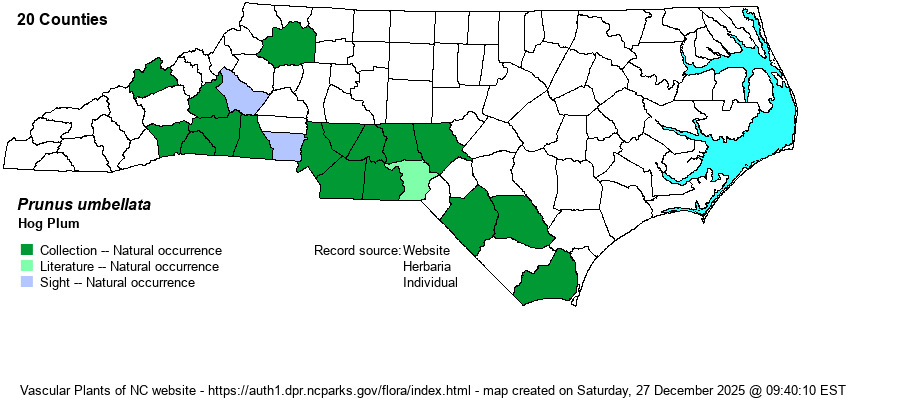| Section 6 » Order Rosales » Family Rosaceae |
Show/Hide Synonym
| taxonName | relationship | relatedTaxonName | relatedTaxonRefText | relComments |
|---|
|
|
|
|
| Prunus umbellata | > | Prunus umbellata var. umbellata | | | | Prunus umbellata | > | Prunus umbellata var. injucunda | | | | Prunus umbellata | > | Prunus umbellata | Small (1933, 1938) | | | Prunus umbellata | > | Prunus mitis | Small (1933, 1938) | | | Prunus umbellata | > | Prunus injucunda | Small (1933, 1938) | | | Prunus umbellata | < | Prunus umbellata | Flora of North America (1993b, 1997, 2000, 2002a, 2002b, 2003a, 2004b, 2005, 2006a, 2006b, 2006c, 2007a, 2009, 2010) | | | Source: Weakley's Flora |
|
| Author | Elliott | |
| Distribution | Present over most of the southern Piedmont and adjacent foothills, and in the southwestern Coastal Plain. Ranges north to Burke and Moore counties, with an outlier specimen from Wilkes County (that perhaps needs more confirmation), the northern extent of the total range. Occurs in the southern Mountains, at least adjacent to the Piedmont. A 2024 collection from Bertie County proves to be P. americana.
The species ranges north only to central NC, n. AL, and central AR; it occurs south to the Gulf Coast and southern FL.
| |
| Abundance | Rare to very uncommon in the southern Piedmont and adjacent Mountains, where it is more widespread than elsewhere. Rare to locally uncommon in the southern Coastal Plain. Can be fairly common to common where found, however, such as in the Uwharrie Mountains on monadnocks with high pH soil. This is an NC Watch List species. | |
| Habitat | It has two distinct habitats -– in the Piedmont and southern Mountains it occurs on dry circumneutral soils (such on some monadnocks in the Uwharries) in upland hardwood forests, in some areas where rocky. In the Coastal Plain, it is found mainly on sandy soils in pine or mixed forested areas, apparently not of high pH. This may suggest that two entities are involved (full species?). |
| Phenology | Flowers in March and April, and fruits in August and September. | |
| Identification | This is mainly a small and stocky deciduous tree, or a large shrub; it may often grow at least 20 feet tall. Though it does not grow in dense colonies, where it is found it may be common and a major low understory component. However, it is very ordinary looking, with elliptical leaves that are finely toothed, like so many other species; the leaves average about 2.5 inches long and about 1.5 inches wide. It has a reddish to purple fruit that is roughly 1/2-inch long, which will help in identification, as will the white flowers; at least the reproductive parts will let one know he/she is looking at a plum or cherry. Because it is not a numerous species in the state, unless you are specifically aware of it or are looking for it, individuals can easily be passed over for many other genera, such as a holly (Ilex). | |
| Taxonomic Comments | Decades ago it was named as Prunus mitis, among other names. Weakley (2018) mentions “It is presently unclear how best to treat variation in this complex”, which refers to the differing habitats of the species in different parts of the range (as mentioned under Habitat above). There do appear to be two distinct taxa (species?) lumped together under one name as P. umbellata – a Coastal Plain form of sandy soil and a Piedmont and mountain form of rocky soil with a higher pH.
| |
| Other Common Name(s) | Flatwoods Plum, Black Sloe, Sloe Plum | |
| State Rank | S2 [S3] | |
| Global Rank | G5 | |
| State Status | W7 | |
| US Status | | |
| USACE-agcp | | |
| USACE-emp | | |

